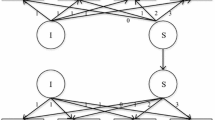Abstract
We assessed the utility of an empirically-derived classification system for youths with emotional and behavioral disorders in a system of care with a strong representation of juvenile delinquents. Eighty-seven youths served in a system of care were categorized by variables related to past history, current behavioral functioning, and current psychological functioning into four clinical clusters. We evaluated preliminary clinical outcomes after six months of interagency involvement for youths within each cluster and across the four clusters. Results indicated that youths in different clusters improved significantly in need-specific areas. Trends in our data indicated differential change in clinical outcomes across clusters. We discuss our findings within the context of emerging outcomes of youths involved in comprehensive community-based programs and consider implications for outcome research, treatment of juvenile delinquents, and mental health policy.
Similar content being viewed by others
REFERENCES
Achenbach, T. M. (1991). Manual for the Child Behavior Checklist/4–18 and 1991 Profile. Burlington: University of Vermont Department of Psychiatry.
Armistead, L., Wierson, M., Forehand, R., & Frame, C. (1992). Psychopathology in incarcerated juvenile delinquents: Does it extend beyond externalizing problems? Adolescence, 27, 309-314.
Bank, L., Marlowe, J. H., Reid, J. B., Patterson, G. R., & Weinrott, M. R. (1991). A comparative evaluation of parent-training interventions for families of chronic delinquents. Journal of Abnormal Child Psychology, 19, 15-33.
Bickman, L. (1996). A continuum of care: More is not always better. American Psychologist, 51, 689-701.
Bickman, L., Guthrie, P., Foster, E. M., Lambert, E, W., Summerfelt, W. T., Breda, C., & Heflinger, C. A. (1995). Evaluating managed mental health care: The Fort Bragg experiment. New York: Plenum Publishing.
Borduin, C. M. (1994). Innovative models of treatment and service delivery in the juvenile justice system. Journal of Clinical Child Psychology, 23, 19-25.
Borduin, C. M., Mann, B. J., Cone, L. T., Henggeler, S. W., Fucci, B. R., Blaske, D. M., & Williams, R. A. (1995). Multisystemic treatment of serious juvenile offenders: Long-term prevention of criminality and violence. Journal of Consulting and Clinical Psychology, 63, 569-578.
Carnegie Corporation of New York (1994, April). Starting point: Meeting the needs of our young children. New York: Author.
Center, D. B. (1990). Social maladjustment: An interpretation. Behavioral Disorders, 15, 141-148.
Damery, Furlong, M. J., Casas, M., & Corral, C. (1996). Third annual Santa Barbara County Children's Scorecard. Santa Barbara: KIDS Network.
Eppright, T. D., Kashani, J. H., Robison, B. D., & Reid, J. C. (1993). Comorbidity of conduct disorder and personality disorders in an incarcerated juvenile population. American Journal of Psychiatry, 150, 1233-1236.
Friedman, R. M. (1996). The Fort Bragg Study: What can we conclude? Journal of Child and Family Studies, 5, 161-168.
Friedman, R. M., & Burns, B. J. (1996). The evaluation of the Fort Bragg Demonstration Project: An alternative interpretation of the findings. Journal of Mental Health Administration, 23, 128-136.
Henggeler, S. W., Melton, G. B., Smith., L. A., Schoenwald, S. K., & Hanley, J. H. (1993). Family preservation using multisystemic treatment: Long-term follow-up to a clinical trial with serious juvenile offenders. Journal of Child and Family Studies, 2, 283-293.
Hodges, K., & Wong, M. M. (1996). Psychometric characteristics of a multidimensional measure to assess impairment: The Child and Adolescent Functional Assessment Scale. Journal of Child and Family Studies, 5, 445-467.
Kazdin, A. E. (1992). Research design in clinical psychology (2nd ed.). Needham Heights, MA: Allyn & Bacon.
Kazdin, A. E. (1994). Methodology, design, and evaluation in psychotherapy research. In A. E. Bergin & S. L. Garfield (Eds.), Handbook of psychotherapy and behavior change (4th ed., pp. 19-71). New York: Wiley.
Kazdin, A. E., & Bass, D. (1989). Power to detect differences between alternative treatments in comparative psychotherapy outcome research. Journal of Consulting and Clinical Psychology, 57, 138-147.
Lambert, E., & Guthrie, P. (1996). Clinical outcomes of a children's mental health managed care demonstration. Journal of Mental Health Administration, 23, 51-68.
Quinn, K. P., Newman, D. L., & Cumblad, C. (1995). Behavioral characteristics of children and youth at risk for out-of-home placements. Journal of Emotional and Behavioral Disorders, 3, 166-173.
Rosenblatt, A. B., & Attkisson, C. C. (1992). Integrating systems of care in California for youth with severe emotional disturbance I: A descriptive overview of the California AB377 Evaluation Project. Journal of Child and Family Studies, 1, 93-113.
Rosenblatt, J. A., Robertson, L. M., Bates, M. P., Wood, M., Furlong, M. J., & Sosna, T. (1998). Troubled or troubling? Characteristics of youths referred to a system of care without system-level referral constraints. Journal of Emotional and Behavioral Disorders, 6, 42-54.
Singh, N. H., Landrum, T. J., Donatelli, L. S., Hampton, C., & Ellis, C. R. (1994). Characteristics of children and adolescents with serious emotional disturbance in systems of care. Part I: Partial hospitalization and inpatient services. Journal of Emotional and Behavioral Disorders, 2, 13-21.
Weisz, J. R., Walter, B. R., Weiss, B. F., Fernandez, G. A., & Mikow, V. A. (1990). Arrests among emotionally disturbed violent and assaultive individuals following minimal versus lengthy intervention through North Carolina's Willie M. Program. Journal of Consulting & Clinical Psychology, 58, 720-728.
Zwick, R., & Attkisson, C. C. (1985). Effectiveness of a client pretherapy orientation videotape. Journal of Counseling Psychology, 32, 514-524.
Author information
Authors and Affiliations
Corresponding author
Rights and permissions
About this article
Cite this article
Rosenblatt, J.A., Furlong, M.J. Outcomes in a System of Care for Youths with Emotional and Behavioral Disorders: An Examination of Differential Change Across Clinical Profiles. Journal of Child and Family Studies 7, 217–232 (1998). https://doi.org/10.1023/A:1022947417228
Issue Date:
DOI: https://doi.org/10.1023/A:1022947417228




